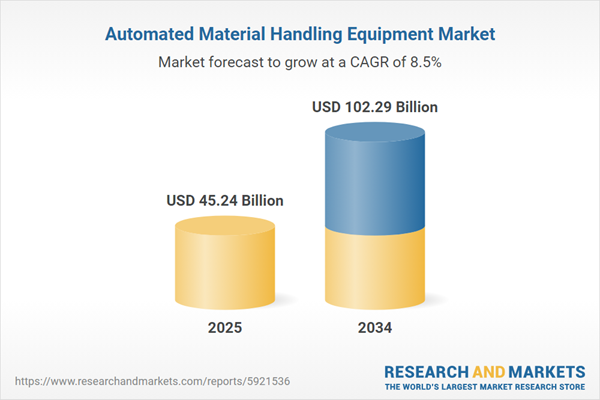Key Trends in the Market
Automated material handling equipment refers to automation solutions that reduce or eliminate the need for human intervention throughout the product manufacturing process, offering enhanced efficiency during production. It includes the use of various robots and automated devices for the movement, storage, and control of different materials used in facilities.- Some of the automated material handling equipment market trends include the growing popularity of Industry 4.0 and the advent of Industry 5.0, plant modernisation efforts, and the increasing incorporation of automation technologies in manufacturing processes. In addition, there is a surge in investments by manufacturers and companies to streamline backend operations and improve revenue by automating processes and increasing business efficiency.
- Advancements in technologies such as artificial intelligence (AI) and the Internet of things (IoT) are expected to accelerate the automated material handling equipment market growth in the forecast period. Improvements in tracking, automation, and coordination, along with the advent of 5G technology and the increasing complexity of material handling technologies, are likely to benefit the automated material handling systems market.
- The rapid development of smart factories with reduced wastage and enhanced operational effectiveness is anticipated to propel the automated material handling equipment market demand in the upcoming years. Automated material handling systems can improve asset performance, offer real-time actionable information, and enhance diagnostic speed.
- The thriving e-commerce sector and the increasing demand for quick, accurate, and efficient customer services are driving the demand for automated material handling equipment to enhance efficiencies in warehouses and automate processes like packaging, processing, material handling, and storage. Each piece of equipment and modular products can be integrated into systems that control all or different levels of automated supply chains like Warehouse Management System (WMS) or Warehouse Control System (WCS), resulting in a fully connected ecosystem.
Market Segmentation
The Expert Market Research's report titled “Automated Material Handling Equipment Market Report and Forecast 2025-2034” offers a detailed analysis of the market based on the following segments:Market Breakup by Component
- Software
- Hardware
- Services
Market Breakup by Product
- Robots
- Automated Storage and Retrieval Systems (ASRS)
- Conveyor and Sortation Systems
- Cranes
- Automated Guided Vehicles (AGV)
Market Breakup by System Type
- Unit Load Material Handling Systems
- Bulk Load Material Handling Systems
Market Breakup by End Use
- Automotive
- Semiconductors and Electronics
- Food and Beverages
- Chemicals
- Pharmaceuticals
- Aviation
- Others
Market Breakup by Region
- North America
- Europe
- Asia-Pacific
- Latin America
- Middle East and Africa
Market Share by End Use
As per the automated material handling equipment market analysis, the automotive sector extensively deploys automated solutions and computerised devices, including robots/robotic arms, to ensure optimal movement of heavy parts across the assembly line and eliminate the requirement for manually moving and lifting different components.Automated material handling solutions also improve employee safety, reduce maintenance costs, and enhance automotive manufacturers' efficiency, uptime, and return on investment (ROI). Meanwhile, in the food and beverage sector, growing attempts to optimise different processes, improve sanitation, and ensure accurate packaging are likely to boost the usage of material handling equipment in the forecast period.
Market Share by Region
North America represents a significant portion of the automated material handling equipment market share due to the growing adoption of automation technologies in the region. The introduction of stringent government regulations aimed at ensuring the safety of workers in workplaces is also fuelling the adoption of material handling automation solutions in North America.The Asia-Pacific automated material handling equipment market is also growing due to factors like rapid industrialisation and the increasing adoption of advanced technologies by manufacturers. There is also a surging demand for different types of material handling systems in flourishing end-use sectors like automotive, e-commerce, healthcare, and food and beverages.
Competitive Landscape
The report gives a detailed analysis of the following key players in the global automated material handling equipment market, covering their competitive landscape and latest developments like mergers, acquisitions, investments and expansion plans.Daifuku Co., Ltd.
established in 1937, is a pioneer in the automated material handling system market. Its systems combine storage, conveying, control, sorting, and picking to serve diverse sectors such as manufacturing and automotive. Headquartered in Osaka, Japan, the company uses innovative technologies to meet the diverse requirements of its customers.
Jungheinrich AG
is a leading intralogistics company that is based in Hamburg, Germany. The company has established its position as a pioneer in the material handling sector and aims to develop warehouses of the future through its innovative solutions. The company is committed to all areas of intralogistics, ranging from industrial trucks to automated intralogistics solutions.Kardex Holding AG
is a prominent intralogistics solution provider and one of the largest suppliers of material handling systems and automated storage systems. It also maintains, develops, and produces dynamic retrieval and storage systems and automated high-bay warehouses. With its presence in nearly 30 countries, the company is listed on the Swiss SIX Stock Exchange.Other automated material handling equipment manufacturers include KION GROUP AG, SSI SCHAEFER Group, Honeywell International Inc, KNAPP AG, Mecalux, S.A., Siemens AG, KUKA AG, Toyota Industries Corp., BEUMER Group GmbH & Co. KG, Krones AG (System Logistics S.p.A.), Interroll Holding AG, TGW Logistics Group, and viastore SYSTEMS GmbH.
Table of Contents
Companies Mentioned
The key companies featured in this Automated Material Handling Equipment market report include:- Daifuku Co., Ltd.
- Jungheinrich AG
- Kardex Holding AG
- KION GROUP AG
- SSI SCHAEFER Group
- Honeywell International Inc
- KNAPP AG
- Mecalux, S.A.
- Siemens AG
- KUKA AG
- Toyota Industries Corp.
- BEUMER Group GmbH & Co. KG
- Krones AG (System Logistics S.p.A.)
- Interroll Holding AG
- TGW Logistics Group
- viastore SYSTEMS GmbH
Table Information
| Report Attribute | Details |
|---|---|
| No. of Pages | 179 |
| Published | August 2025 |
| Forecast Period | 2025 - 2034 |
| Estimated Market Value ( USD | $ 45.24 Billion |
| Forecasted Market Value ( USD | $ 102.29 Billion |
| Compound Annual Growth Rate | 8.5% |
| Regions Covered | Global |
| No. of Companies Mentioned | 17 |








